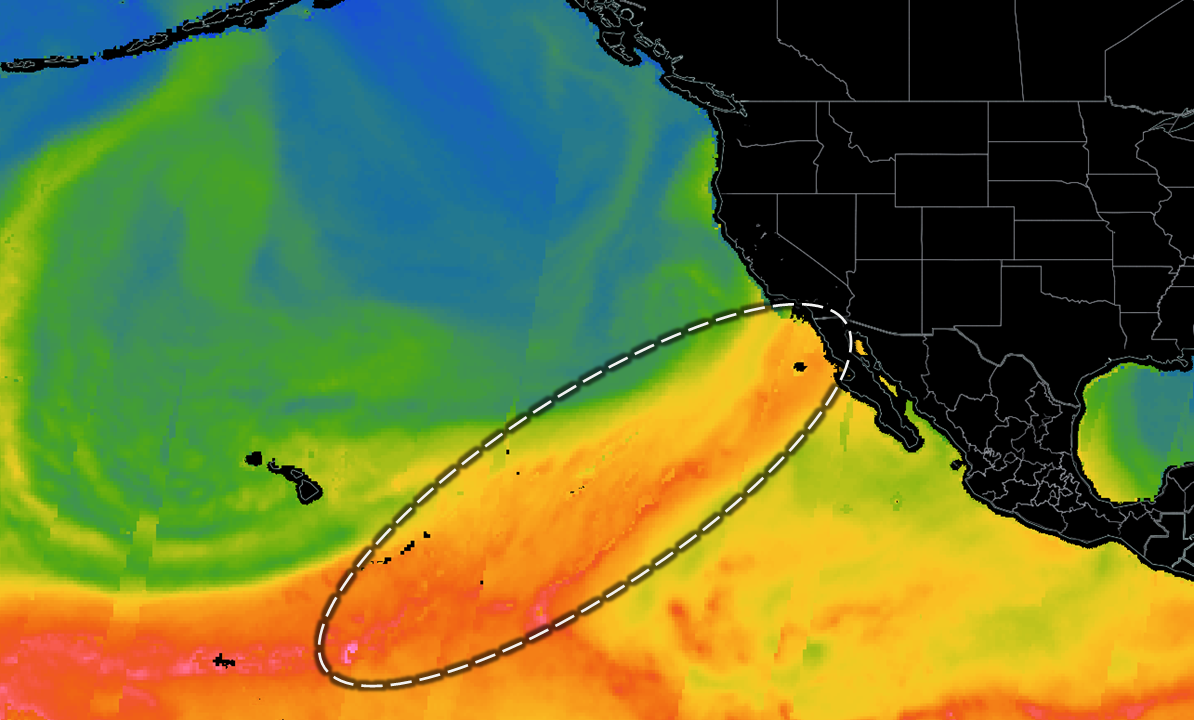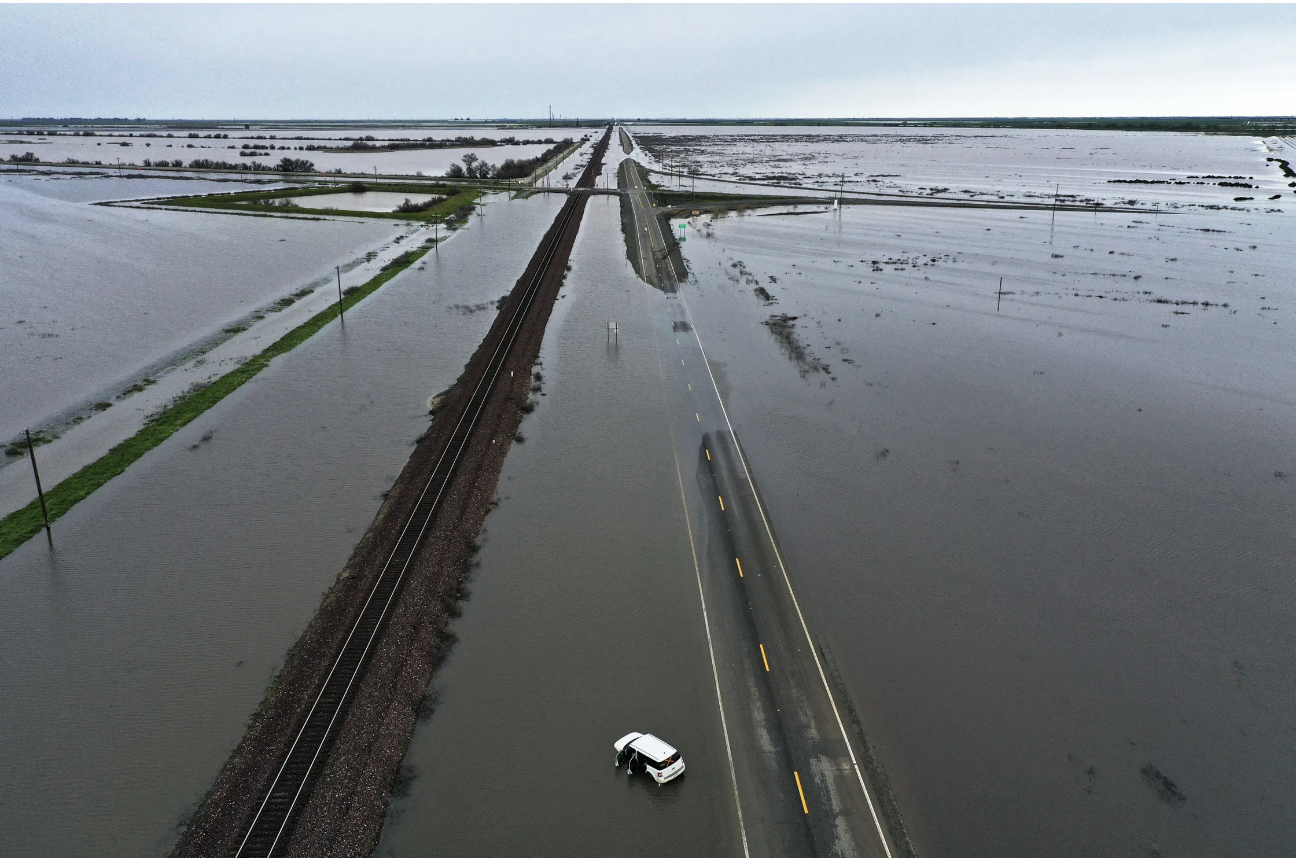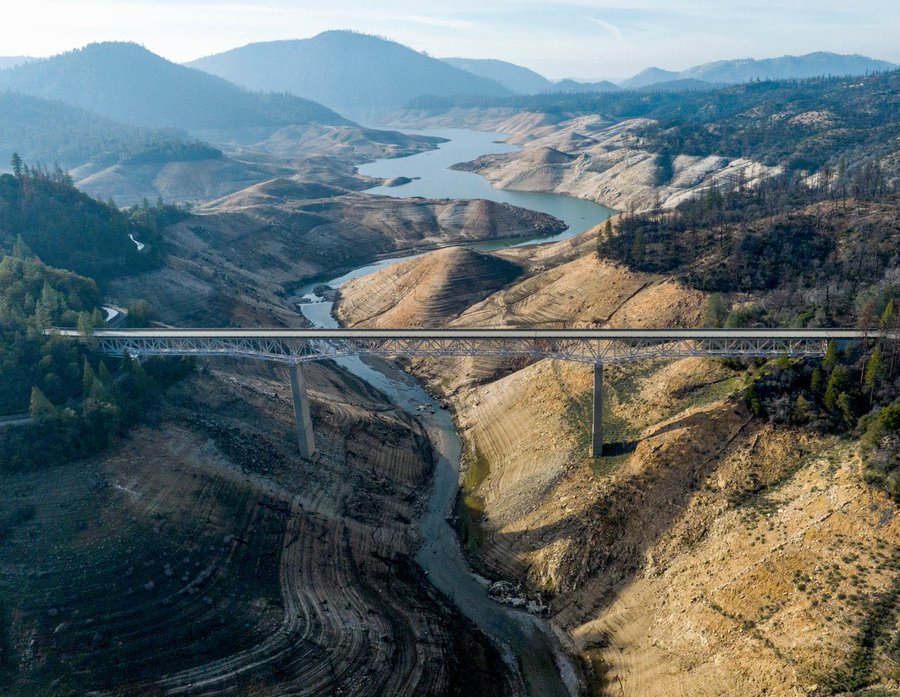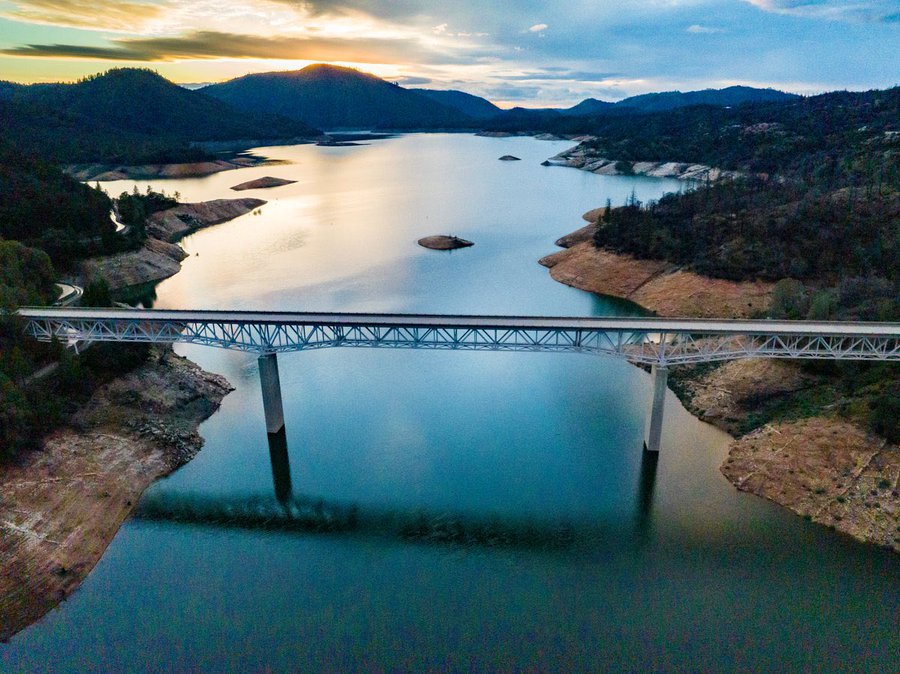What is an atmospheric river?
- An atmospheric river is a large band of moisture in the atmosphere, usually thousands of miles/kilometers long and hundreds of miles/kilometers wide. Atmospheric rivers transport substantial quantities of water vapor, which later precipitates as rain or snow (image below). According to the National Oceanic and Atmospheric Administration (NOAA), atmospheric rivers vary in size and intensity, but strong ones can hold more water than the entirety of the Amazon River.
- In combination with strong winds, atmospheric rivers can pick up large amounts of dust, sand, and other small particles. Examples carrying significant amounts of dust are referred to by scientists as ‘aerosol atmospheric rivers.’

Satellite image of the Pineapple Express, an atmospheric river in the Pacific Ocean stretching from Hawai’i to the west coast of North America, taken in February 2019. Warmer colors indicate greater quantities of water vapor (NASA, 2022).
What is happening?
- In June 2019, an atmospheric river dumped 10 to 20 centimeters (4 to 8 inches) of rain on southern Chile, along the west coast of South America over the span of two days. The region normally receives this much precipitation in a month. Concepción, a major city in southern Chile, experienced flooding, and landslides were reported in surrounding regions.
- In March 2022, aerosol atmospheric rivers transported millions of tons of Saharan dust from North Africa northward to the Mediterranean and Western Europe. France, Spain, and Portugal were most severely affected. The dust degraded air quality and painted skies orange (image below).

Photograph of a home in Naveres, Spain after Saharan dust plumes in spring 2022 (Feehan, 2022). The sky is orange due to the dust particles carried from the Saharan desert by an atmospheric river.
- In winter 2023, the U.S. state of California received over 30 trillion gallons (113 trillion liters) of water over the course of several months. Affected areas experienced 11 to 25 inches of rain (28 to 64 cm). This came as a great relief to the region, which is in the midst of a severe megadrought. The precipitation temporarily replenished water reservoirs and added to mountain snowpacks.
- An atmospheric river called the Pineapple Express was responsible for this weather phenomenon. The Pineapple Express transports atmospheric moisture east across the Pacific Ocean from Hawai’i to the west coast of North America (satellite image above).
- This record-breaking rain event was accompanied by flash floods, storm surges, and high-speed wind gusts (image below). Officials reported at least twenty fatalities in California.

Photograph of flooded highway in California, U.S. after heavy winter storms in 2023. The state’s flood control system was overwhelmed by the intense precipitation, and many low-lying and flat areas were inundated (Bittle, 2023).
How is this related to climate?
- Atmospheric rivers are part of the global cyclone system, which transfers heat and water vapor from tropical latitudes to the poles. These phenomena form under conditions of high humidity and mild winds. They often extend across large bodies of water, but lose their moisture over land. Most of the water vapor in atmospheric rivers is precipitated when they reach high topographical features, like mountain ranges.
- Like many other natural phenomena such as wildfires, droughts, and heat waves, atmospheric rivers are predicted to become more intense due to anthropogenic climate change. With rising global temperatures, evaporation rates are increasing and adding to atmospheric moisture. Furthermore, rising air temperatures allow the atmosphere to hold more moisture. Water vapor is also collecting in centralized storms, reducing the number of mild storms and increasing the strength of major ones. As a result, atmospheric rivers are growing larger and stronger under hotter conditions.
- Atmospheric rivers are categorized on a scale from 1 to 5, based on their potential for infrastructure damage, with 1 being less hazardous and 5 being the most hazardous. For areas in drought, weaker atmospheric rivers (categories 1 and 2) can be beneficial in providing temporary relief.
What are the implications?
- Human-induced climate change is disrupting climate systems, altering the distribution of moisture around the world. Water vapor is being collected in some areas and taken away from others. Stronger atmospheric rivers are coinciding with periods of intense droughts.
- In 2021 and 2023, California experienced heavy rain events during a decades-long megadrought. Because of anthropogenic climate change, California is predicted to continue fluctuating between extreme wet and dry conditions. This is dangerous for natural environments and local economies. Climate models anticipate that on the current trajectory of climate change, flood damage can increase by over $3 billion by the end of the century.
- Atmospheric rivers are bringing rainfall to California in short periods of time, quicker than the region can capture it. Precipitation from atmospheric rivers fills local reservoirs (image below), but the amount of rainfall exceeds their capacity. Consequently, a lot of freshwater overflows into the ocean, unable to be used. In an effort to prevent this, the state has upgraded its flood control and reservoir infrastructure.

Images of Lake Oroville, California’s second-largest reservoir. The top image was taken in September 2021 during low lake levels, and the bottom image was taken in March 2023, soon after an atmospheric river event caused the lake level to rise (Skinner, 2023).

References and additional resources
- Bittle, J. “California’s Atmospheric Rivers Are Getting Worse.” WIRED. 2023. https://www.wired.com/story/california-atmospheric-river-climate-change/.
- Carlowicz, M. “Atmospheric River Swells Terrestrial Rivers.” NASA Earth Observatory. 2019. https://earthobservatory.nasa.gov/images/145260/atmospheric-river-swells-terrestrial-rivers.
- Corringham, T. “Atmospheric river storms can drive costly flooding, and climate change is making them stronger.” Phys.org. 2021. https://phys.org/news/2021-10-atmospheric-river-storms-costly-climate.html.
- Feehan, K. “Red alert! Sahara Desert dust cloud which could be worst on record spreads from Spain to Switzerland brings an eerie glow to the skies.” Daily Mail.com. 2022. https://www.dailymail.co.uk/news/article-10616511/Sahara-Desert-dust-cloud-spreads-Spain-Switzerland-brings-eerie-glow-skies.html.
- Gray, J. “What is an atmospheric river?” CNN. 2023. https://www.cnn.com/2023/03/09/weather/what-is-an-atmospheric-river-xpn/index.html.
- Lin II, R. G. “‘Dry’ California got big rains. Was it really an epic weather forecasting fail?” Los Angeles Times. 2023. https://www.latimes.com/california/story/2023-01-23/dry-winter-was-predicted-why-did-california-storms-bring-so-much-rain.
- NASA. “Atmospheric Rivers.” NASA EarthData. 2022. https://ghrc.nsstc.nasa.gov/home/micro-articles/atmospheric-rivers.
- Pratt, S. “An Atmospheric River of Dust.” NASA Earth Observatory. 2022. https://earthobservatory.nasa.gov/images/149588/an-atmospheric-river-of-dust.
- Skinner, A. “Photos Show California Reservoir Water Levels Before and After Major Storm.” NewsWeek. 2023. https://www.newsweek.com/photos-show-california-reservoir-water-levels-before-after-major-storm-1788060.
- Smith, E. “Climate change may lead to bigger atmospheric rivers.” NASA Global Climate Change: Vital Signs of the Planet. 2018. https://climate.nasa.gov/news/2740/climate-change-may-lead-to-bigger-atmospheric-rivers/.
- “What are atmospheric rivers?” NOAA. 2023. https://www.noaa.gov/stories/what-are-atmospheric-rivers.
- Wholf, T. J. “What are atmospheric rivers? How climate change impacts the storms they produce.” ABC News. https://abcnews.go.com/US/atmospheric-rivers-climate-change-impacts-storms-produce/story?id=96143911.
